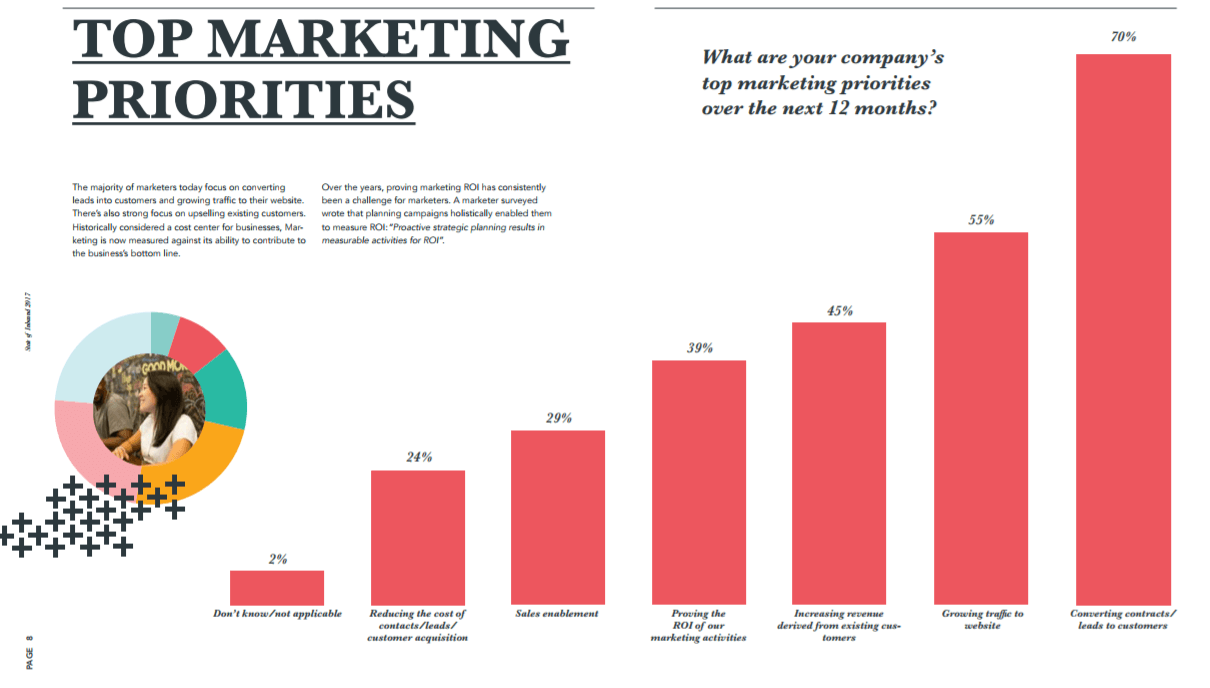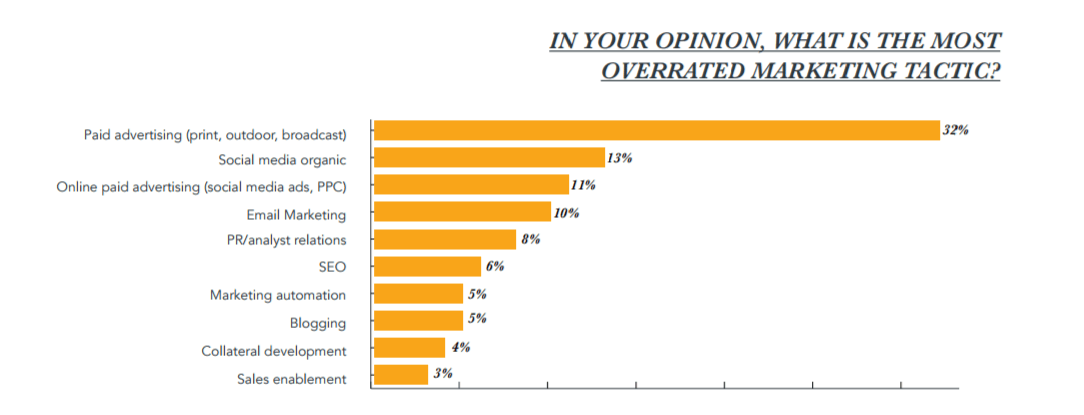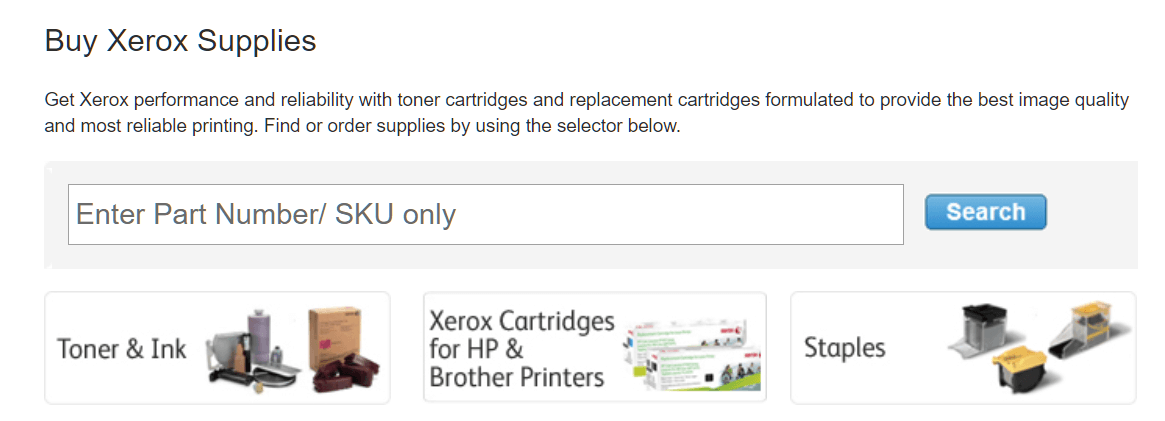
Inbound Marketing, Advertising, or CRO: Which is Most Important?
Between inbound marketing, paid ads, and conversion optimization, it can be hard to know where to start. Consider this approach.

Inbound marketing is gaining ground on outbound marketing, but both have one major challenge: If your traffic doesn’t convert (no matter how you get that traffic) it pays you nothing. A huge spike in the number of visitors may draw a cheer from the marketing team, but unless there’s a corresponding uptick in sales, it’s going to draw hard questions from the C-suite.
In today’s marketing reality, return on investment and bottom line sales are the only things that matter in the end. If the cost of the traffic you’re getting isn’t justified by the sales that traffic generates, you won’t have a job long. It really is that simple. But how do you make sure the traffic you’ve worked so hard to acquire is the source of a steady stream of blockbuster revenue? That’s where conversion rate optimization (CRO) comes in.
In this white paper, we’ll give you the facts you need to show your CMO exactly what’s lacking in your current strategy and how to fix it. Here’s our code word: “frictionless.”
Inbound Marketing vs. Outbound Marketing: Which is Best?

We’ve found there’s considerable confusion around the definitions of “inbound” and “outbound” marketing. You can find more detailed and nit-picking descriptions, perhaps, but we like to keep it simple. Here’s how we differentiate between inbound and outbound tactics:
Inbound marketing: Tactics that draw visitors to your ecommerce website and/or landing pages. Your website content, your social media presences, and your search engine optimization efforts are all examples of inbound marketing. “Content marketing” is often used interchangeably, but content marketing is actually a subset of inbound marketing.
Outbound marketing: Tactics that push your message out to your audience. Advertising, direct mail, and your email marketing campaigns are examples of outbound marketing. The lion’s share of the outbound budget (excellent term for it) usually goes to PPC advertising. Confusion arises when we look at the results instead of at the efforts. Your blog, for example, provides (pushes) content that draws visitors to your site. Since the blog is on your website, though, visitors must come there to read it.
That’s why we list blogging as an inbound tactic. You can take the content of the blog, though, print it on paper, and mail the article to prospects. That would be an outbound technique – since there would be no need for readers to come “inbound” to see the message. Inbound marketing tactics happen on your website. Outbound tactics happen elsewhere. To debate whether inbound or outbound marketing is best, then, is kind of like wondering whether one should breathe in or out. We need both, and (done correctly) they both have the same goal: increased sales.
Here’s one more term we need to be clear on:
CRO: The acronym for “conversion rate optimization.” These tactics are aimed at getting the traffic generated by inbound and outbound marketing to convert from being interesting prospects to becoming paying customers. Much of CRO is concerned with removing barriers from the sales path. The aim of CRO is a frictionless journey. That’s the ideal, but like perfect health, there’s always more work needed.
A primary mistake we find businesses of all sizes making is focusing on inbound/outbound marketing efforts, leaving little or no room in the marketing budget for conversion rate optimization. That’s like leading the proverbial horse to a dry watering hole. Not only CAN’T you make him drink, you don’t have anything FOR him to drink. CRO doesn’t guarantee overnight results, but it does make them possible. Here’s what we mean…
How CRO Solidifies Inbound Marketing and Outbound Marketing Efforts
The typical ecommerce marketing budget breakdown is too low on developing better inbound marketing efforts, heavy on outbound marketing (predominantly PPC and social media advertising), and slim or none at all on conversion rate optimization.
We’ve elsewhere made the case for a balanced budget – one that would provide a third of available funding to each of the three primary marketing areas: inbound marketing, outbound marketing, and CRO. We’ve seen companies make HUGE leaps in return on investment by making room in the budget for conversion rate optimization strategies. Here are a few of those case studies:
- Xerox boosted conversions by 86.7% with CRO
- Snow Peak saw a 149% increase in online revenue
We could go on and on citing real companies with real results, but the company we’re most concerned with right now is yours! Why aren’t you investing as much in CRO as you are in advertising?
Most of the ecommerce managers we speak with KNOW conversions are the key, but they can’t get management to let go of the idea that enough advertising and enough traffic will cure all ills. After all, the sales are “in the numbers,” right? Wrong. The sales are in the prospects who convert to paying customers, and CRO is the part of that three-legged stool (inbound marketing strategy, outbound marketing strategy, and conversion rate optimization strategy) that addresses conversions. The other two are primarily concerned with getting more traffic.
Here are some pertinent statistics to consider…
Inbound marketing stats
HubSpot’s State of Inbound 2017 report surveyed over 6,000 marketers to identify top challenges and priorities. One glaring result from the study was that top executives who set company goals and the ecommerce managers and team members who execute the tactics to achieve those goals “have very different perspectives on the state of [the] business.” To bridge that gap, Inbound 2017 suggests that the C-suite needs “a better understanding of the day-to-day challenges…” and the staff needs “to communicate more clearly the roadblocks in the way of success.” That’s exactly what this white paper hopes to accomplish for your company.
Let’s look at a few of the results from that report, beginning with top marketing priorities (see the graph below).

Reducing the cost of leads and customer acquisition is the top priority for 24 percent of marketers polled. Given that lowering the cost of traffic is a primary aim of inbound marketing (since, unlike advertising, there’s no need to pay for every acquisition individually), this is a tell-tale sign. One could extrapolate that inbound marketing is seen as the top priority for less than a quarter of the marketers surveyed.
As noted in the copy included with the graphic (taken from the State of Inbound 2017 report) Hubspot reports, “Historically considered a cost center for businesses, marketing is now measured against its ability to contribute to the business’s bottom line.” That’s often the twist that confuses many longtime practitioners of marketing. The budget no longer flows so freely.
The classic Wanamaker observation that ““Half the money I spend on advertising is wasted; the trouble is I don’t know which half” is no longer a valid excuse for lackluster returns. Management wants to see maximum value for each dollar spent on marketing – outbound or inbound. Note further that 55 percent of respondents say getting more traffic to the site is the top marketing priority.
That is primarily the domain of outbound marketing – yes, we’re being liberal in our interpretation, yet our experience with businesses and management over the years correlates well with these findings. More effort and funding is invested in outbound methods (advertising) than on anything else – even when the results are poor. The real eye opener, though, should be the “Converting contracts/leads to customers” column.
While more than two-thirds of marketers believe conversions are their most pressing concern, most try to achieve those conversions by getting more traffic instead of figuring out how to leverage more of the traffic they already have! When we point out the gaping CRO hole that desperately needs filled, it’s easy to figure that – since conversion rate optimization is what we do – OF COURSE we’re going to see it as crucial. Moreover, many ecommerce managers tell us they get stonewalled by management, too. The idea that more traffic solves everything is pervasive – even in the best of companies. But it could be that C-suite sentiments are on a pendulum swing back in the other direction.
Consider this bar graph (below) from the study:

Outbound marketing stats
It’s the elephant in the room, and nobody wants to talk about it: advertising costs more and returns less than ever before. The only ones sure to get windfall profits from ads are those who sell them. We talk to business owners who have hopped from Google PPC to Bing ads to Facebook ads and beyond, who are sick of the game. They’re wasting money, and they know it. They desperately seek a better strategy than driving as much traffic as one can muster and hoping visitors will buy. There’s a magic wand – a missing bullet – that can accomplish that mission.
Rather than blame Google for lost ad revenue, smart marketers invest in conversion rate optimization. They shoot for a frictionless sales path that will turn prospects into buyers and then into repeat customers. Leverage the power of CRO. Meanwhile, the first quarter of 2017 broke the record for internet advertising revenue. MediaKix reported advertising sales hit $19.6 billion. The total spend on digital advertising in 2016 was $72.5 billion, with mobile ads accounting for half of the investment. Social media claimed about a quarter of the spend. Here are some pertinent stats from Nielsen and HubSpot about outbound marketing:
- 85 percent of display ad clicks come from eight percent of viewers. In other words, most people rarely click on banner ads. The average CTR for a banner ad is 0.1 percent.
- Click fraud is a growing problem with ads. It’s estimated that up to 11 percent of clicks are from bots, not from humans.
- Marketers still haven’t figured out how to correctly target their ads. 70 percent fail to include behavioral data in their targeting.
We’re not trying to throw the baby out with the bathwater. Done right, advertising can be a cost-effective way to get more traffic. Best-practice CRO looks back to the ad and makes sure it ties in perfectly with the landing page. Here again, ‘frictionless’ conversion rate optimization is the goal. CRO seeks to greet the prospect and guide that prospect by the hand to the cash register. When that happens, advertising begins to make sense again.
Conversion rate optimization stats

Both inbound and outbound marketing seek to draw consumer attention to your ecommerce website, your landing pages, and your offers. Conversion rate optimization tactics seek to build a frictionless and seamless path to convert that attention into sales. One of the most amazing statistics we’ve found is this: For every $92 invested on acquiring traffic (inbound and outbound marketing), only one dollar is invested on converting those visitors into buyers! That finding, from the Econsultancy Conversion Rate Optimization Report (2016) soundly presents the most persuasive argument we know of for boosting the CRO share of the marketing budget to AT LEAST equal that invested on inbound and outbound marketing. What could be clearer than that?
Here are a few more CRO statistics from that Econsultancy report. You’ve just uncovered the one strategic move that can potentially provide a major boost in ROI without any additional spending on advertising or content.
Conversion rate optimization is coming into its own. There’s a growing tendency for marketers to wake up to the need for CRO. The 2016 study found that more than half of the companies surveyed said CRO is “crucial to their overall marketing strategies.” Another third said CRO is “important.” This should be a shot-in-the-arm for every digital marketer. If you fail to fund and embrace CRO, your competition might. A well-orchestrated CRO strategy can spell the difference between failure and success for any campaign. See the graph below for more a yearly comparison.
Marketers consistently cite “lack of resources” as the most significant barrier to focusing on conversion rate optimization. That’s why The Good launched a free Score Your Site tool to help identify problem areas. Based on those results, can implement a Conversion Growth Program – all without having to do any additional in-house hiring or training whatsoever. Not having qualified conversion rate optimization specialists on the staff isn’t a show-stopper. Actually, it’s normally better to engage a third-party advisor. Eyes looking from the outside in can see much differently than eyes looking from the inside out.
CRO is not a one-time makeover sort of endeavor. Continued testing and adjusting is necessary to get the best results. Moreover, the tests should reach beyond simple A/B testing. Ecoconsultancy found that companies frequently running tests seen as ‘complex’ or ‘highly complex’ were twice as likely to realize a ‘significant increase’ in sales, when compared to companies that never or rarely run more sophisticated tests.
Inbound Marketing + Outbound Marketing + CRO Is the Perfect Combination for Sales Success
Here are some of the benefits to the three-legged stool approach (Inbound Marketing + Outbound Marketing + CRO) we’ve found in our extensive experience with conversion rate optimization at The Good:
- The cost per lead for outbound marketing is more than the cost per lead for inbound marketing. CRO can decrease the costs of both. Many of the companies we work with find they can safely dial back the outbound expense and direct more of the budget to inbound + CRO. Unlike advertising costs, inbound and CRO strategies keep on paying back without charging you for every click, view, or sale.
- Inbound marketing typically generates a greater ROI than does outbound marketing. Here again, CRO can increase that ROI even more.
- Done correctly, inbound marketing is a natural for reducing friction in the way it attracts visitors to your site. CRO reduces friction once they’ve arrived. Together, inbound marketing and CRO are a perfect combination for striving towards that ‘frictionless’ approach.
Again, don’t think we’re dismissing advertising as a potent tool. Our experience shows us, though, that most companies are placing outbound marketing/advertising at the head of the line when it comes to the marketing budget. We think that’s a mistake. We’ve seen expenses drop and revenues increase (AKA “huge ROI boosts”) when ecommerce managers convince the C-suite to back off on the ad spend, then dial the inbound marketing and conversion rate optimization shares of the budget up to at least match the outbound investment.
In the end, it isn’t uncommon at all for the budget to flip-flop – with the largest share going towards CRO and inbound marketing and ad spend dropping to the bottom of the budget. That not only feels good; it can pay off handsomely. We’ll wrap it up by going over the particulars of the three case studies we referenced earlier: Xerox and Snow Peak.
CRO Case Studies: Real Results from Companies Who Proved the Value of CRO to ROI

These companies – all clients of The Good – have generously given us permission to share a part of their CRO experiences with you. They are early-adopters of the principles we teach. We haven’t chosen these three because their results are necessarily more spectacular than other clients. These cases are entirely typical of what we see every day in our work. That’s what makes our jobs extremely gratifying.
Xerox Almost Doubled the Conversion Rate for Returning Visitors
The Xerox ecommerce team wanted to reduce the cart abandonment rate for their B2B printer and printer supplies online shop. Their Stuck Score™ assessment and complimentary report revealed a series of usability issues affecting the site. We enrolled Xerox in a Conversion Growth Program™ and launched a series of tests aimed at better identifying and correcting those problems. That enabled us to shoot for a ‘frictionless’ path to purchase and an expedited checkout process. Consequently, Xerox gained the following results:
- The conversion rate for returning visitors grew by 86.7 percent
- CRO tactics on the product detail pages drew an 18.9 percent growth in add-to-cart conversions
- Changes in the call to action resulted in 15.2 percent more engagement and a 3.4 percent growth in add-to-cart conversions
Xerox proved the value of CRO to the bottom line. They continue to use our data-driven insights to shoot for a ‘frictionless’ user experience (UX) and turn more browsers into buyers.
Snow Peak Grew Online Revenue By 149 Percent
Snow Peak sells premium quality outdoor lifestyle products. They came to The Good with a desire to completely overhaul their website, but they weren’t sure of the best place to begin. Like many companies we mentor, Snow Peak was spending a big chunk of their marketing budget on traffic acquisition, but they weren’t realizing a sufficient ROI on that spend.
Additionally, the average order value was deemed insufficient and the conversion rate was unacceptable. Snow Peak needed a makeover. We led Snow Peak through the same trio of remedies mentioned above for Xerox: Stuck Score™, site audit report, and Conversion Growth Program™.
Consequently, we uncovered a bevy of blockages that were causing friction and blocking visitors from following the path on to the final conversion as paying customers. Following testing and the application of tactics designed to correct the problems – looking towards the frictionless path – Snow Peak enjoyed the following results:
- The year-over-year sales revenue increased by 149 percent
- The average order value grew by 30 percent
- The visitor-to-buyer conversion rate grew by 108 percent
Consequently, Snow Peak’s brand manager, Russell Borne, said this: “We saw a 30% increase in average order value, and that wasn’t throwing money into the black hole of digital advertising, but tweaking and honing in the site to be effective.”
Inbound Marketing, Outbound Marketing, and CRO – Which is Most Important?
Don’t make the mistake of focusing on inbound marketing and advertising, but downplaying the value of ongoing conversion rate optimization. You need all three. We’ll close with one more quote from Snow Peak’s Russell Borne:
“Working with The Good has changed how I’ve thought about what success is for the web. It’s not just revenue that I am looking at, it is order value and it is conversion rate.”
When your average order value and conversion rates rise to meet the traffic demand you’ve already generated, your ROI can move the right direction significantly – without needing to dump more money into pay-per-click ads. Not only that, but those ad dollars are gone once they’re used.
Conversion rate optimization improves the substance of your business. It pays you back over and over and over again. To get a better feel for what CRO can do for your business, drop your current numbers and your desired numbers into this CRO calculator – with an eye on how your monthly online revenue can multiply as a result: CRO Revenue Growth Calculator. Then, schedule a few minutes with our team to learn…
A huge spike in the number of visitors may draw a cheer from the marketing team, but unless there’s a corresponding uptick in sales, it’s going to draw hard questions from the C-suite.
In today’s marketing reality, return on investment and bottom line sales are the only things that matter in the end. If the cost of the traffic you’re getting isn’t justified by the sales that traffic generates, you won’t have a job long.
It really is that simple.
But how do you make sure the traffic you’ve worked so hard to acquire is the source of a steady stream of blockbuster revenue?
That’s where conversion rate optimization (CRO) comes in.
In this white paper, we’ll give you the facts you need to show your CMO exactly what’s lacking in your current strategy and how to fix it.
Here’s our code word: “frictionless.”
In this white paper we cover:
- Inbound marketing vs outbound marketing: which is best?
- How CRO solidifies inbound and outbound marketing efforts
- Inbound marketing stats
- Outbound marketing stats
- Conversion rate optimization stats
- CRO case studies: real results from companies who proved the value of CRO to ROI
